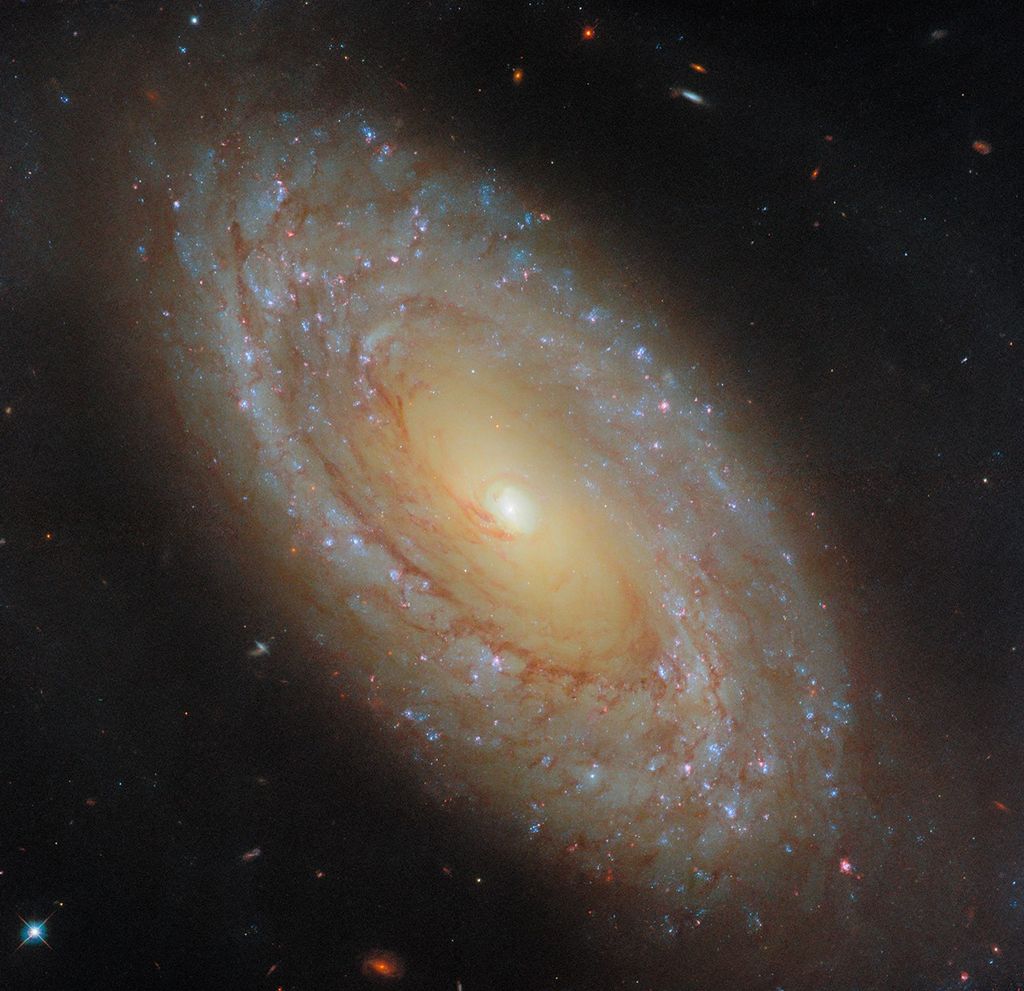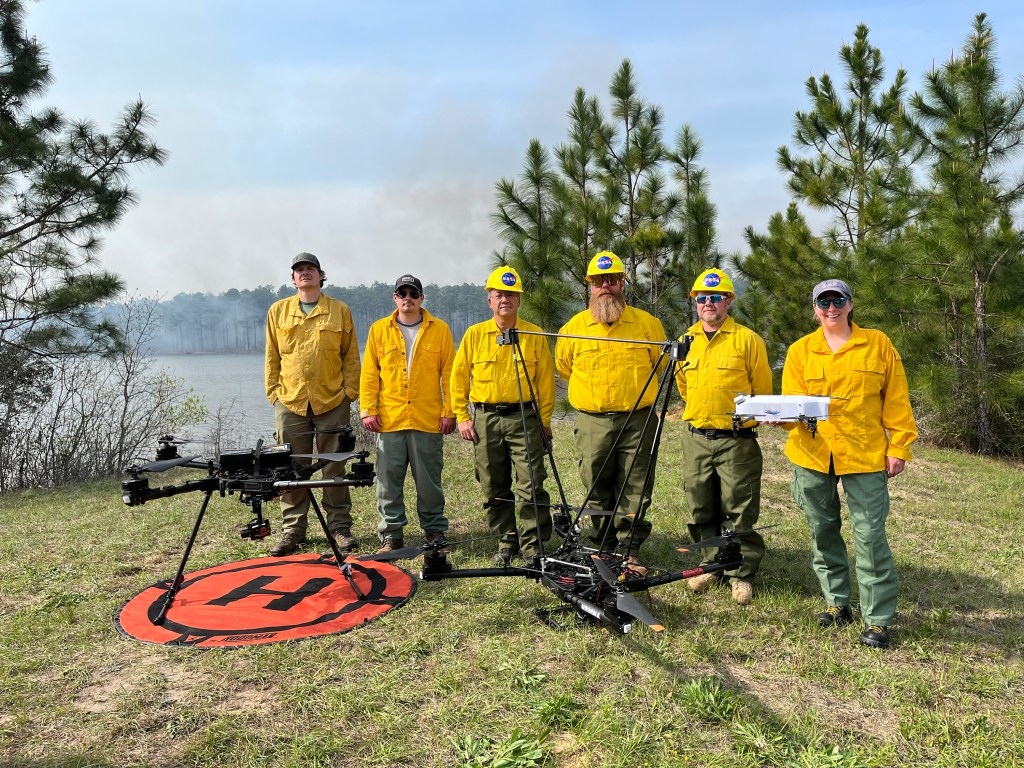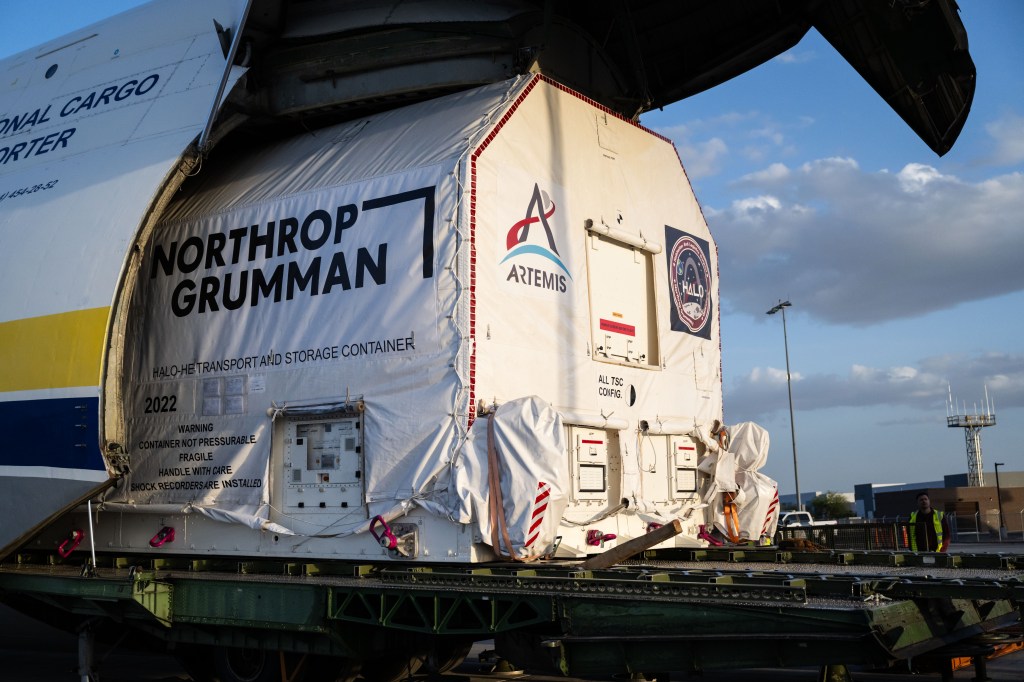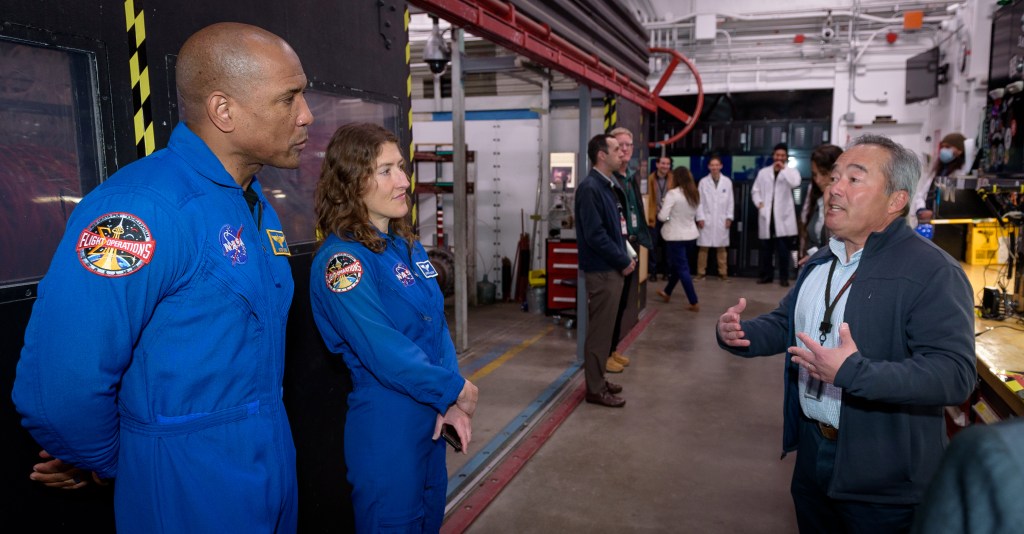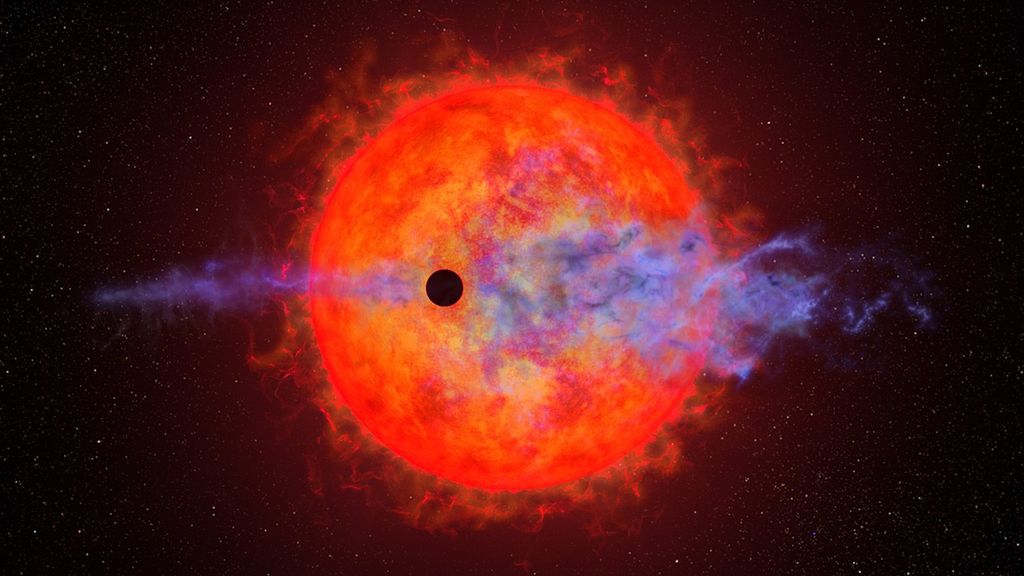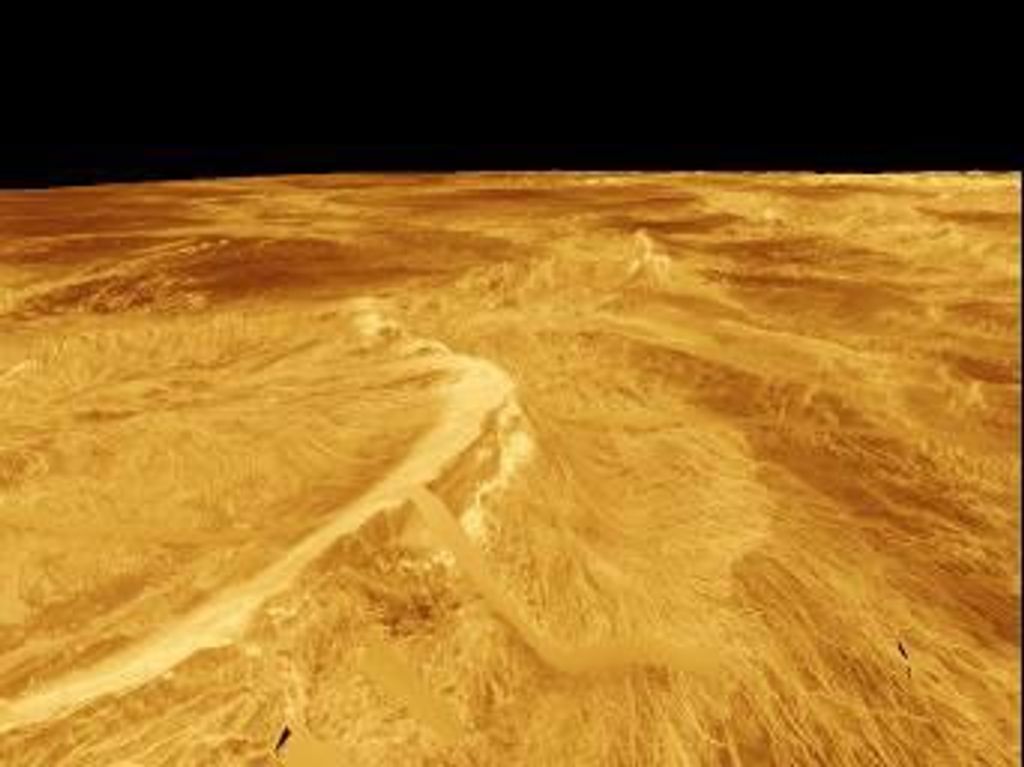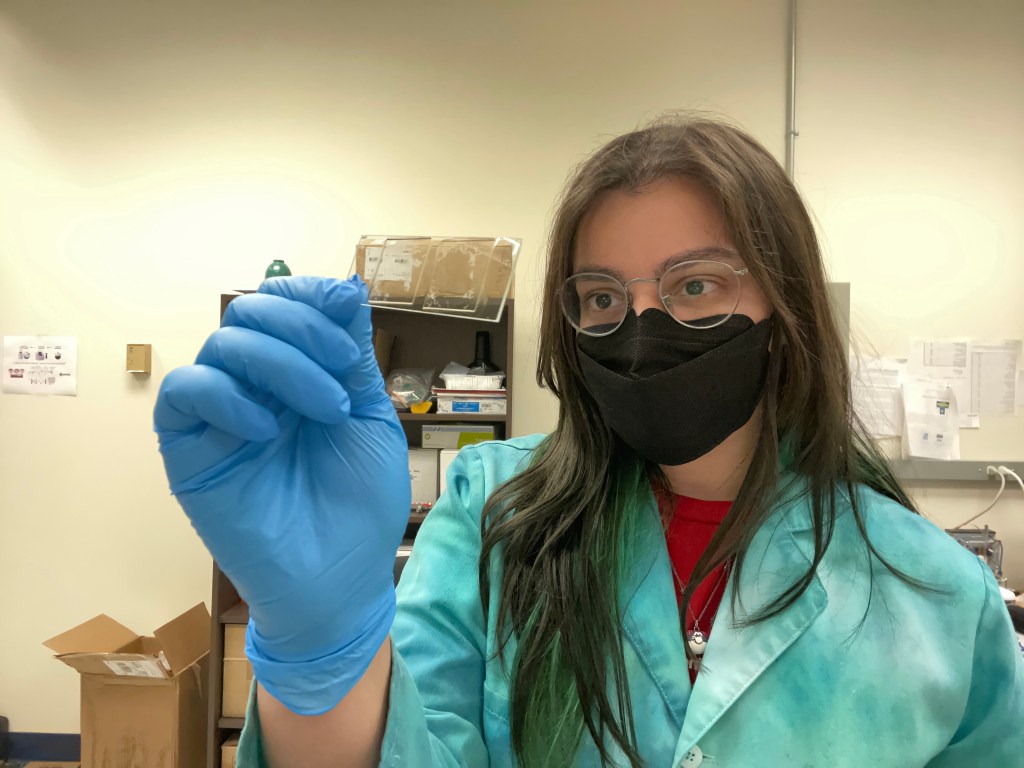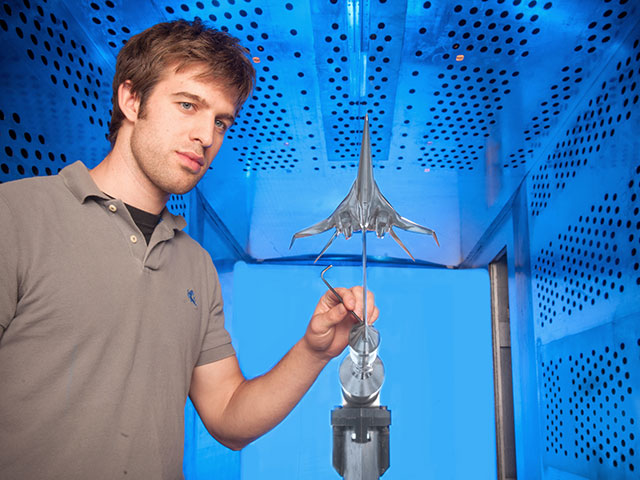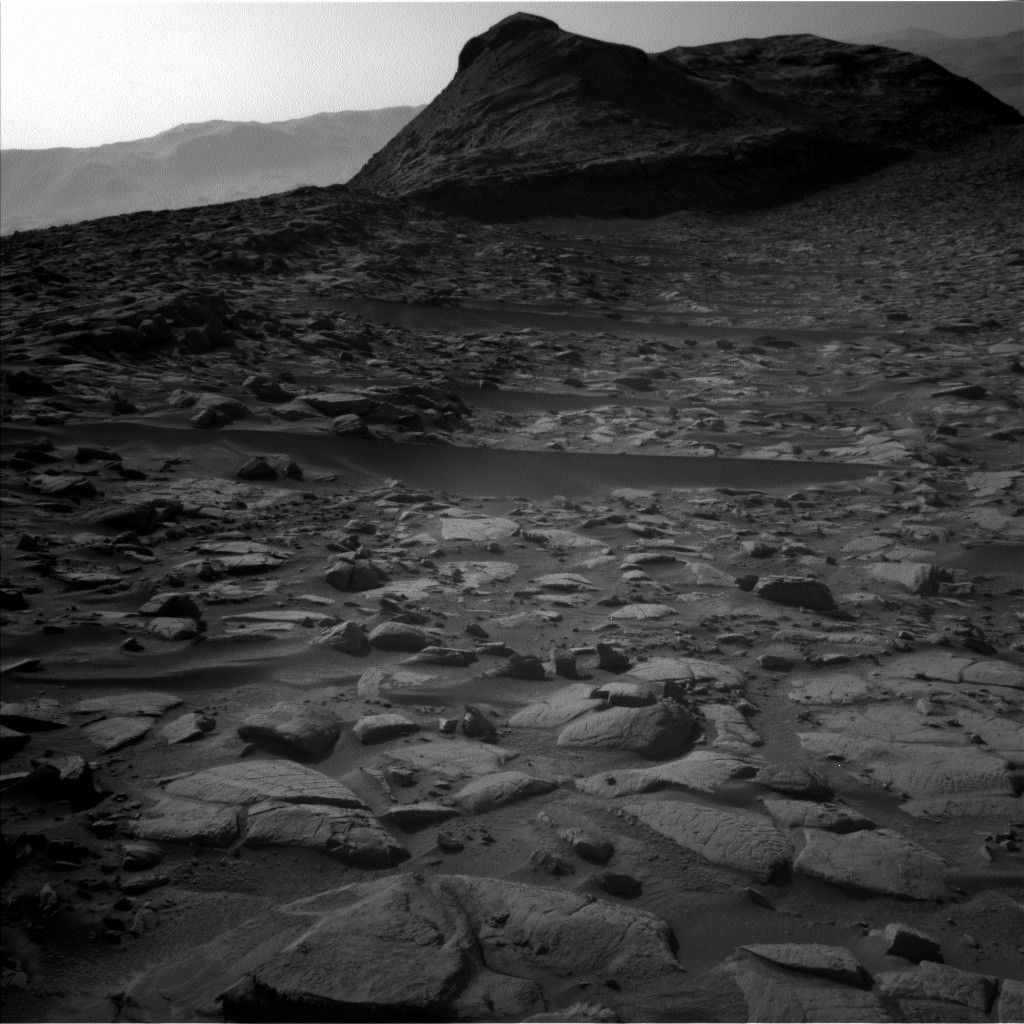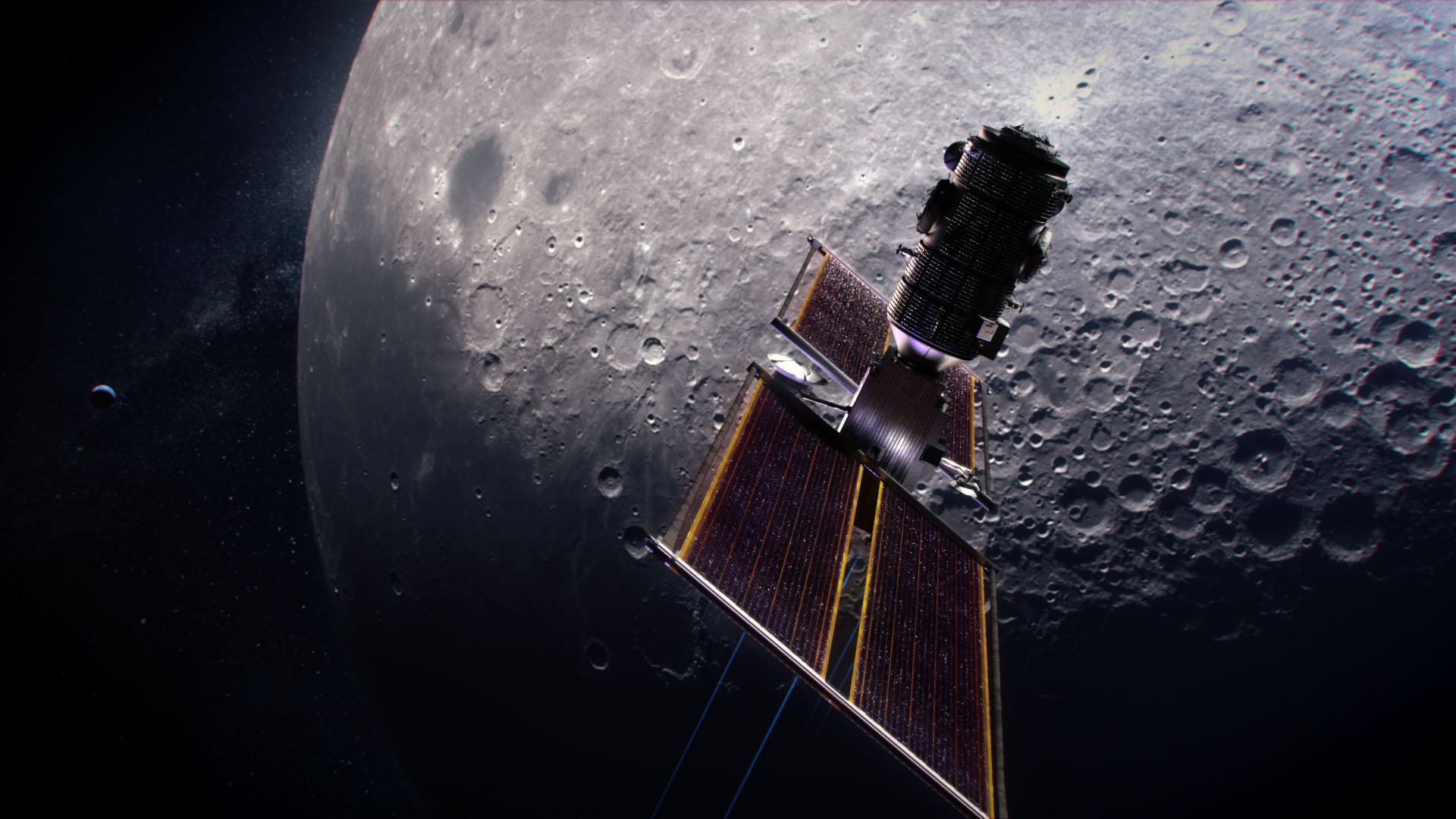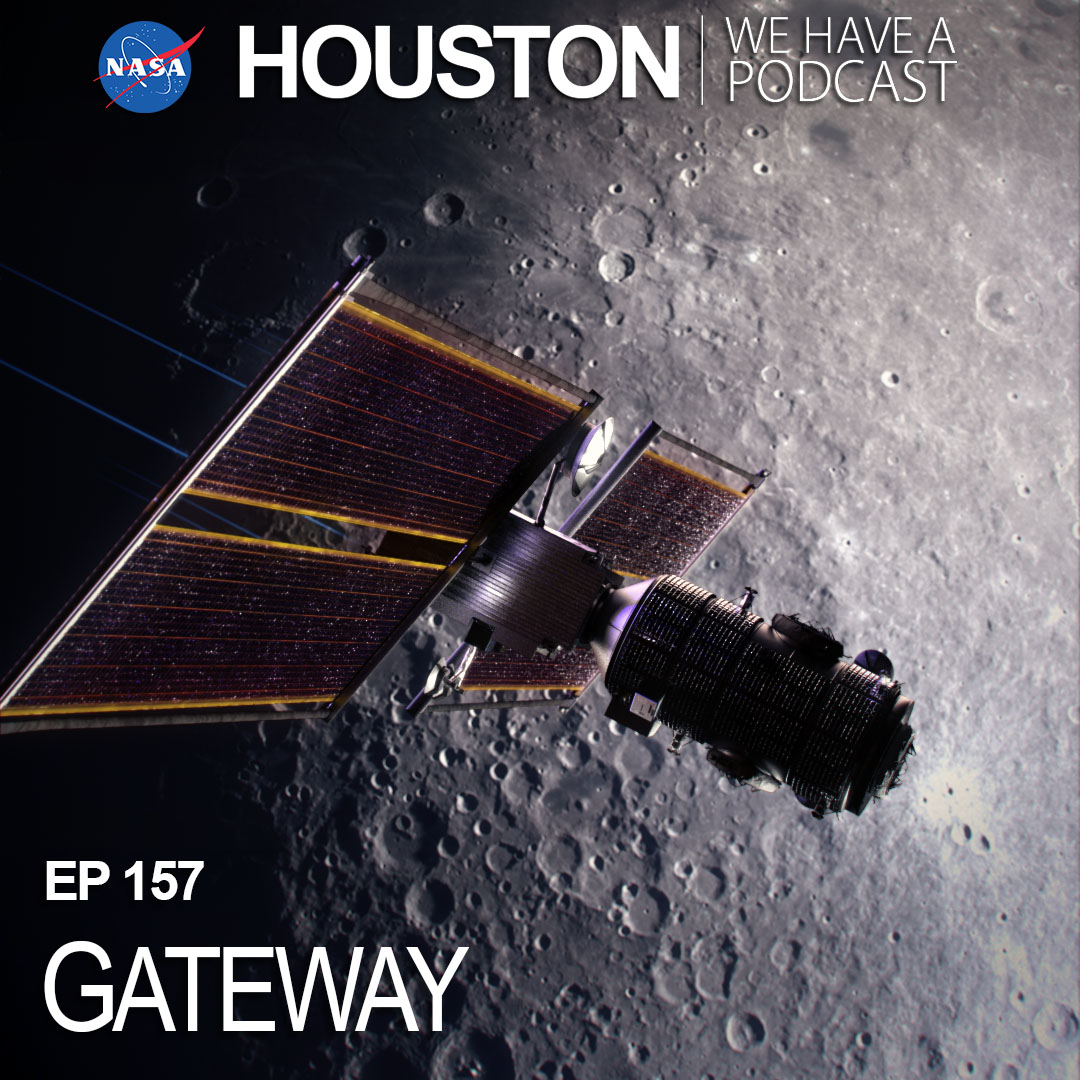
If you’re fascinated by the idea of humans traveling through space and curious about how that all works, you’ve come to the right place.
“Houston We Have a Podcast” is the official podcast of the NASA Johnson Space Center from Houston, Texas, home for NASA’s astronauts and Mission Control Center. Listen to the brightest minds of America’s space agency – astronauts, engineers, scientists and program leaders – discuss exciting topics in engineering, science and technology, sharing their personal stories and expertise on every aspect of human spaceflight. Learn more about how the work being done will help send humans forward to the Moon and on to Mars in the Artemis program.
On Episode 157, Dan Hartman and Lara Kearney, Gateway Program Manager and Deputy Program Manager, respectively, detail the plans for our orbiting lunar outpost and how Gateway will serve as a docking and service station for Artemis missions as we prepare for sustainable human presence on the Moon. This episode was recorded on July 9, 2020.
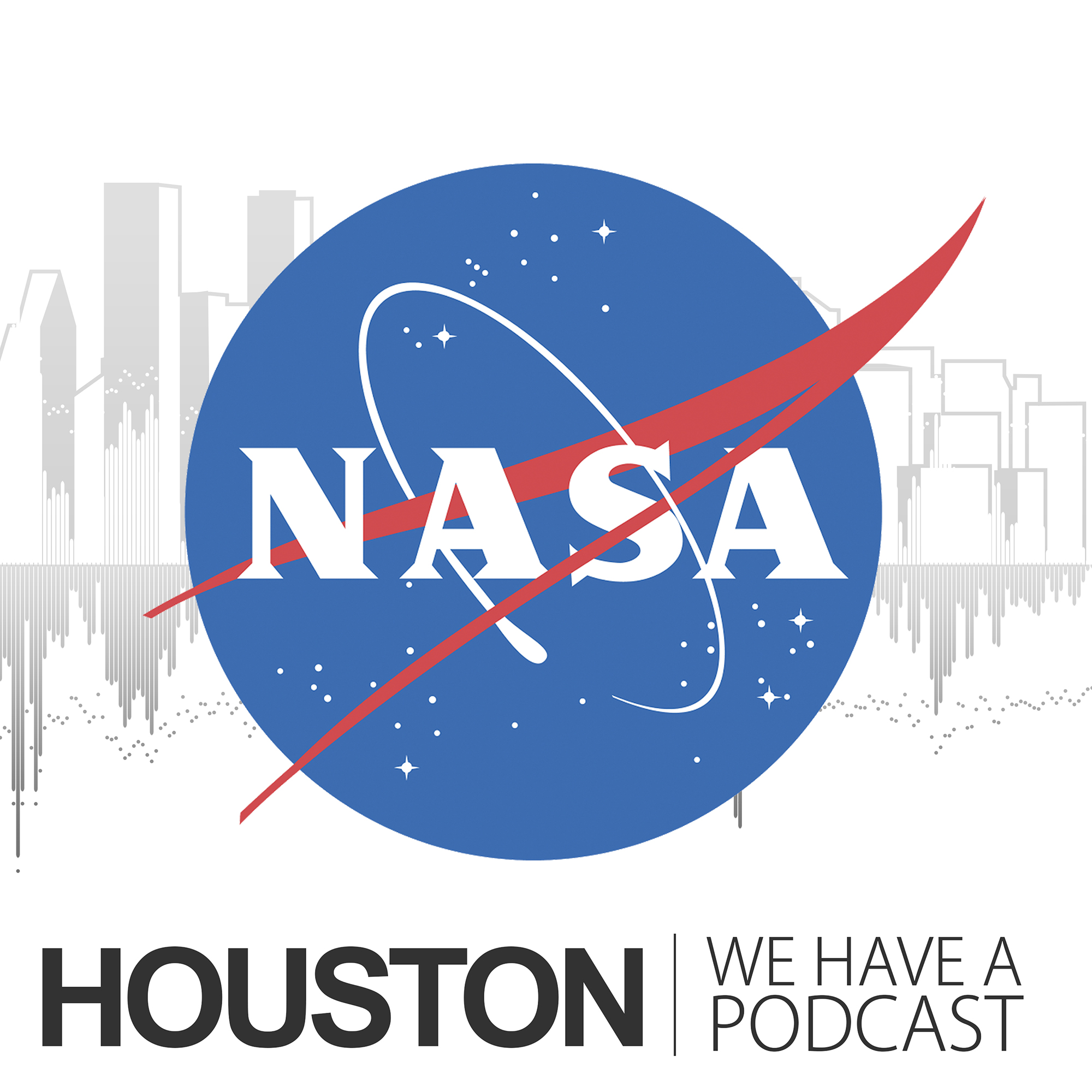
Transcript
Gary Jordan (Host): Houston, we have a podcast. Welcome to the official podcast of the NASA Johnson Space Center, Episode 157, “Gateway.” I’m Gary Jordan and I’ll be your host today. On this podcast we bring in the experts, scientists, engineers, astronauts, all to let you know what’s going on in the world of human spaceflight. We talk about Artemis quite a bit on this podcast. This is NASA’s program to return to the Moon sustainably, under a new architecture. One of the key elements of a sustained presence on the Moon is an outpost orbiting around it, called the Gateway. If you’re like me, you may be thinking, is this like the International Space Station, but around the Moon instead of Earth? It’s actually pretty different. Not just the location, but the orbit is unique, the size, the elements, all framed within a new way of doing business. So here to describe the Gateway, and what it is, and what it has completed thus far, is Dan Hartman and Lara Kearney, Gateway Program Manager and Deputy Program Manager respectively, here at the Johnson Center. They’re the ones leading the charge in building this from the ground up. Not just the Gateway, but the program itself. So here we go. The outpost around the Moon, known as Gateway for NASA’s Artemis program with Dan Hartman and Lara Kearney. Enjoy.
[ Music]
Host: Dan and Lara, thanks so much for coming on Houston We Have a Podcast today.
Lara Kearney: Good afternoon.
Dan Hartman: Howdy.
Host: Hey guys. So excited to have you both on to talk about Gateway. I think a lot of people are curious on just what this thing is, and how it folds into this grander picture we have called Artemis. But before we begin, I think what’s exciting is between the two of you, you have such diverse experiences here at NASA. So, Dan, I’m going to pitch it over to you first. Understanding a little bit about what you’ve done at NASA, a little bit about your background and who you are as the leader, the manager of this new program we have here. Dan, take it away.
Dan Hartman: Yes, thank you Gary. Appreciate you doing this. It’s a great opportunity for Lara and I to describe what we’ve been up to for the last year and a half. Let’s see. I grew up in the St. Louis area, and moved down here actually, in the Clear Lake area, when I was 16 years old. My father got transferred. And so, went to high school in the JSC vicinity, and ended up going to Texas A&M University and received an electrical engineering degree. What was cool about that, up at Texas A&M, is I got to work on a senior project that was actually one of the first remote sensing payloads that flew on the Space Shuttle program. So, we had a kind of professor that was leading the charge. I guess kind of like the [Principal Investigator] PI. And he got a bunch of students together to figure out how to go fly this thing. We started the project off, and then a couple years later, as senior classes came through, they actually flew the device on the shuttle. So that was really cool. Got me really excited into space. And so out of college, I joined McDonnell Douglas for about nine years. I did a lot of work with cargo integration, payload integration in the back of the shuttle. For that duration, and then in 1994 I joined NASA and right on in to the ISS program. And geez, up until about a year and a half ago, I was in the ISS program, I worked my way up to the ISS vehicle manager, the [International Space Station Mission Management Team] IMMT chairman, and eventually the deputy program manager to both Mike Suffredini and Kirk Shireman. And then was given the opportunity to come join the Gateway program. And it’s been a fun ride ever since.
Host: [laughs] Well, that’s actually going to be part of the story that I want to tell here, is just that ride from when you first became the program manager for Gateway, and just building that program from the ground up. But, Lara first I want to pass it over to you, because your experience is a little bit different, but although your schooling might have been a little the same.
Lara Kearney: Yes, a little bit of the same. Actually, one of the few people that is a native Houstonian. So as a child, I spent a few years in New Orleans. My father was in the oil and gas industry. And so, as a young child I was there. But from the age of ten on, I lived here in Houston on the north side, and kind of funny you know, we would drive often from north Houston to Galveston, and I would pass through this Clear Lake area, and it never even dawned on me I had NASA sitting in my backyard. So, you know, unlike a lot of people at NASA, I was not one of those that said I want to work for NASA and set that path ahead of me. I also went to Texas A&M. I have a bachelor’s and master’s in biomedical engineering. And I was coming close to the end of my bachelor’s degree, and I was seriously considering medical school when NASA showed up on the doorstep to hire biomedical engineers. And it was honestly the first time I thought, wow. Well, that — I could do that right? And kind of come home to the area I grew up in. And so that’s how I landed here. Like Dan, I also started in the contractor community in the health and medical area. I worked for Lockheed for a little while. I worked for Krug Life Sciences for a little while. And then I converted over into a civil servant in 2000. So, I have really — my background is predominately in hardware development. I worked operations a little while, early on. But it’s really been in hardware development the whole time. I worked Shuttle Mir, and then I moved into the EVA world, with spacewalking in 1997. And so, I worked EVA suits from 1997, all the way through 2011. And I was able to kind of ride the Constellation wave there. I was the project manager for the new suit development for Constellation. And when that program was canceled, I moved over to the Orion program in the Crew and Service Module Office. We took the remaining part of the spacesuit from the Constellation program, and we moved it over to Orion. So that’s how I kind of moved into the Orion area. But that was the first taste I had of real spacecraft development was over in Orion in the Crew and Service Module. So, it’s kind of super. I love working with Dan, because he brings in all the ISS ops experience you know? And I kind of have the deep space development experience, and so I think it’s working really well for the two of us.
Host: And that’s what I love, is this — both of you have this diverse experience that kind of adds to this program. So, Lara, I want to lock in on yours for a second. Your experiences. What about your involvement with the deep space programs, and with human health and performance, and all of that, what skills are you contributing to the thoughts of how to operate and build Gateway from the ground up?
Lara Kearney: Well, you know, I — you know, everything we do in our world, money is very important. Right? Money’s a resource, and you have to have funding to be successful. But I learned very quickly in Orion, that when you go into deep space, mass is as critical a commodity as funding actually is. And I think somewhat you know, we got used to operating here in low-Earth orbit, where mass wasn’t quite as critical. So, we, Orion, had to kind of re-learn how to get back into deep space. Again mass, and then just risk acceptance. You know, when you’re on the space station, obviously there’s critical systems there, but we can get a crew home in an hour and a half, or two hours if we have to. When you start taking crews back to the Moon and beyond, these spacecrafts have to be highly reliable, because we can’t get them home quite as quickly. And so, I really learned a lot in Orion on how to make mass trades, and how to make risk trades for crew safety, crew survival, things like that.
Host: Very valuable. I’m hearing money, I’m hearing mass, I’m hearing risk acceptance as some of these top considerations that you’re thinking of for this new program. Now Dan, passing it over to you, your experiences with International Space Station, with shuttle, that you’re bringing to Gateway.
Dan Hartman: Sure. I’ll tell you a lot of hardware development. When I was the ISS vehicle office manager, like you know, we had seven or eight elements sitting down at the [Space Station Processing Facility] SSPF in KSC, going through various stages of integration and testing, getting them ready to go launch. And so how they would go assemble on orbit and continue to fly as individual spacecraft after each one of the assemblies. Got a vast experience in that. You really understand anomalies and failures, even when you test on the ground. And that can be directly applicable to you know, how the systems might react in space. And I tell you the other thing I think I bring to the table is geez, probably for the last 20 years, just heavy, deep involvement with everything associated with the international partners. And it’s so good to be able to carry that from ISS over into the Gateway program. Quite honestly, that’s one of the main attractions that I had to come over and take the job. You know, working with the — Europe, ESA, the Japanese, the Canadians, and a little bit right now with the Russians. You know, I’ll tell you that actually the program mangers that are on the Gateway also have very identical heritage in the ISS program. And so, they’re bringing all that experience into this as well. So, we really hit it off. We’ve got a great working relationship with the international partners. We’re very close to signing the official, formal [Memorandum of Understanding] MOUs that kind of sets in concrete the contributions and benefits that we’ll be able to provide to all the international partners. And as you know, it’s what the international partners are primarily interested, is career opportunities, right? So, their contributions on Gateway will lead to direct flights to the Gateway, eventually, of those international astronauts. So, it’s just a — it’s just one of the bright spots of taking on this job. And being able to apply what we’ve learned on ISS directly onto the Gateway program.
Host: This is fantastic. And I want to take that opportunity to lead into setting up just what this thing is. We’ve described kind of some of the thoughts and considerations and skills going in to building it. Lara, I’ll pass it over to you, from a very high level, what is Gateway?
Lara Kearney: Well, you know — we are going to be — we call it an orbiting platform around the Moon. We try to stay away from terms like “space station,” because there are going to be some fundamental differences between the Gateway and the space station. We are not nearly as big as the International Space Station, nor are we inhabited 24 hours a day, 365 days a year. So, we have some fundamental differences, but we’re basically going to be a habitation outpost around the Moon, and we are there to provide services. A place for landers to aggregate, a place for Orion to bring the crew to, so that we have a sustained, permanent presence around the Moon, and we can support the lunar landing missions.
Host: OK. So, we have an idea of kind of what it is, imagining a smaller space station, not quite the same, I guess elements of a space station. Maybe a little bit smaller, definitely further away. So, Dan, where is this orbiting platform around the Moon? We’re saying, “around the Moon,” but where?
Dan Hartman: Sure. We’re — in fact in late 2023, we’re on track to go launch our first, actually two integrated elements, the [Power and Propulsion Element] PPE and the HALO, into what we call near rectilinear HALO orbit. And that’s basically an orbit around the Moon, that’s I’ll say a halo shape. Kind of gets within about 1,000 miles of the Moon surface, and then kind of spirals out to about to about 40,000 miles away. And it’s a very, very stable orbit. Which really means we use less propellants, less attitude control to maintain how we fly. It’s a good explorer [inaudible]. It’s a good staging point for the Orion spacecraft to come. The lunar landers can aggregate at the Gateway, go down, conduct their sorting missions, and then come back up. And with our logistics resupply missions, out of our Kennedy Space Center friends, they’re going to supply logistics to the crews, to bring up the EVA suits. And so eventually, when we expand the Gateway a little bit further, we’re going to go from this 30-day missions, to 60, to 90-day missions. So as Lara said, we’re not 24/7, but we think as we go further, and the Gateway will enable, I’ll say expansion capability. There are plans out there for kind of your Mars transfer module. Certainly, technology demonstrations of those kind of systems. So yes, we’re 30 days early, but we look to expand that. Because I think the more time you have around the surface, the greater the demonstrations of technology, the greater understanding of reactions with the human body in that environment. So, we’ve got initial plans, and then we’ve got some forward-thinking plans. And we’re trying to make that happen.
Host: Absolutely. That practice is going to be absolutely critical. Now you’ve mentioned a couple of different elements Dan, so I’ll pitch it back over to you to kind of describe what these are. You mentioned HALO, you mentioned PPE. Can you talk about some of these elements that will make up what is Gateway?
Dan Hartman: Sure. You know, in kind of a — actually the first two pieces are critically important. The power propulsion element is actually being built by Maxar and managed out of the Glenn Research Center. It is your power supply, and it is your attitude control for the entire Gateway spacecraft. So, it has reaction wheels. It has reaction control systems to maneuver the Gateway. And you know, we want to conduct excursions around the Moon. Go to different areas around the Moon. And the power propulsion element is the device that’s going to get us there mostly using new technology of the solar electric power. So, we’re really looking forward to getting that element tested and delivered down to KSC. It also provides, like I said, huge amounts of power. Almost 50% of the power that we have on ISS is going to be generated out of the power propulsion element. And so that — those two solar ray wings are going to be the entire stack of the Gateway. So critically important. Critically important. And it mates with HALO, which is a small logistics outpost where we can house the crews early. It has various docking ports on it that can accommodate both the lander and the logistics vehicle, as well as Orion. But on that forward port is where we will continue to expand the capabilities, and we’ll eventually put the [International Habitation module] I-HAB there, on the other end of the HALO. Its primary function is you know, it provides some pressurized volume, some early utilization, which we think is critical. We’ve got some early payloads on the power propulsion element as well. But it is — it’s the nerve center, the command and control center for the whole Gateway. So, our command and control processors, the high-level software will be operating within the HALO module so. Both of those elements are currently on contract, in production, both nearing the [preliminary design review] PDR time period, and like I said, we’re going to put those two together down at KSC. They’ll fly together as one integrated package. It offers us the opportunity to really go test these two elements together. And then we’ll launch in a single rocket that we also are very close to awarding. So, making great progress on power propulsion element, and the HALO.
Host: Very exciting. Lara, Dan is mentioning some scalable opportunities here. We’re going to do this first, and then we’re going to do this later. Can you talk a little bit about that? What those phases look like?
Lara Kearney: Sure. Well, we use the term “initial capability,” and then a “sustained capability.” Our initial capability should be ready in the 2024 timeframe. And it is the HALO and the PPE that Dan mentioned, along with the logistics element. So, for those early missions, you’ll see a HALO and a PPE around the Moon. Orion will come in and bring the crew. And the lander would have already been pre-staged there. So, it’s those elements together. HALO PPE, the logistics module, and with then Orion and the lander. And then as we move to the more sustainable, you’ll see us bring in our international partners. Our international habitat. The Canadian arm. And then we have an element called — what we’re calling an [European System Providing Refueling, Infrastructure and Telecommunications] ESPRIT, which is basically like a refueling element. We’ll be able to refuel and extend the life of the Gateway over time.
Host: Oh wow.
Lara Kearney: We’re hoping eventually too, kind of later in our timeline, we’ll see an air lock. So, we’ll be able to do EVA spacewalking out of the Gateway as well.
Host: Very nice. So, Lara, you said — I think the phrase was “provide services” earlier on when you’re talking about what Gateway is, and how it kind of folds into Artemis. So, you’re thinking — you’ve got early stages, you’ve got later stages. Can you describe a little bit more why we need Gateway for Artemis? What does it provide for these lunar missions?
Lara Kearney: Sure. Yes. You know, there’s a lot of different ways to go to the Moon. You know, Apollo was one of them, and those guys were super smart, and did a great job with the task they had at hand. Their objective at the time was to get there as fast as they could. You know, be the first there. And so, their mission was very optimized. They went around the equatorial region, and the spacecrafts were very optimized for a specific job. When we go back this time, we want to go in a more longer-term sustainable fashion, and we want to be able to explore the entire lunar surface. So, what the Gateway allows the overall Artemis architecture to do is have flexibility in where we can land on the surface, and the ability to re-use spacecraft. Where we already talked about the landers can kind of come and go from Gateway. The ascent element, as it comes from the Moon, back up to the Gateway, we can actually re-use it several times. So, in the long run, it saves us money, and just provides us a longer-term, sustainable program.
Host: Wonderful. I want to take a step back here for a second, because we’ve done a great job so far describing your experiences, and then what this Gateway is. But I want to take it back to the start of the program. Dan, tell me that story from when — you already said you had a lot of experiences with international partners, and they said, “Dan Hartman, we want you to build this program from the ground up.”
Dan Hartman: Yes. And wow. It is truly from scratch. I felt pretty good about you know, my capabilities certainly with the international partners you know, and how to assemble a space station early on. And so — but I didn’t know very much about the Gateway. And so just trying to understand it, and then trying to think of the people, the right people that you want to put in place to help you go manage this. And so, I will tell you, you know, you are really defined by the people. And so, our program office is very small, very nimble. It’s about 25 people. The center — and quite honestly, the centers across the agency were very, very good to us, and enabling us to kind of look over the various — the directorates at JSC and at the other centers, and really kind of I say pick our talent. And amazingly, it’s an incredible group of people. A lot of diverse talent. You know, as — a lot of young people that we’re trying to bring in. We’ve got go-getters we call them, 5-stars, we put some people in stretch positions and you know, quite honestly, early on in the program, you have some time to go learn, and fix things if you know, if you do some mid-course corrections. But Lara and I really took it to heart to try to bring in and mentor some young talent. Because obviously we want to keep this pipeline of future leaders going. So, I’ll tell you, like I said, the ability to go reach across you know, human health and performance, the engineering directorate, the Orion program, the EVA team, we were just able to kind of hand-select the people to make this whole thing go. I will tell you as well, the human resources side at the Johnson Space Center just moved mountains for us to be able to assemble this team fast and quick. And I’ll tell you, it’s kind of a one in a lifetime opportunity to get this ability to kind of hand-pick the folks that you want to work with, that have the talents that you need to carry out the program, we all work hard. We joke with each other. We care about each other. And at the same time, we have a little bit of fun along the way. So very, very proud of the team, and how we’ve been able to grow that bottoms-up. And I will tell you equally Gary, the talent that we have across the other centers, has been amazing as well. And so, you have the Glenn Research Center at the Kennedy Space Flight Center, as well as at Marshall. And we do have pockets of people that support us from other centers as well, but those three in particular, we stay well-tied together. And it’s just a marvelous team that we’ve been able to assemble.
Host: Wonderful. Lara, can you go into more detail about what these different elements are? I’m hearing it’s a small team, but what is the team here at Johnson Space Center focused on? And then it sounds like you have some cross-center help. So, we’re working really across the nation here. What does that all look like?
Lara Kearney: Sure. Like Dan said, we’re pretty small. Just you know, kind of as an example, the space station program office has you know, a couple hundred civil servants. Orion has about 60 civil servants. And like Dan mentioned, we’re at 25. So, what that means is we heavily matrix support, not only from JSC, but as Dan mentioned, from other centers. And the way we are set up, we’ll use the term Level 2, Level 3. We have a Level 2 program, which is really about the integration across the spacecraft. So, we have a program planning and control team that makes sure we’re watching our schedules, and our budget, and the money is flowing the way it should. We have a [Systems Engineering and Integration] SE&I organization that worries about the integrated spacecraft performance. So not only the Gateway, but as our visiting vehicles, like the lander and Orion come and go, they’re worried about how that overall integrated spacecraft is performing across our power systems, thermal systems, propulsion systems. We have a vehicle systems office that worries about basically the down-and-in systems, and how again, the spacecraft performs. We have an [Safety and Mission Assurance] S&MA office to keep our — you know, the crew first and foremost in our minds. Make sure we’re operating safely on orbit. And then we have an operations and utilizations office, who are folding in very early the crew operational needs, and how we’re going to operate the spacecraft, again a little bit differently than we operate space station. But also, how we make the most of the ability to utilize it from a research perspective. So those offices are all here at the Johnson Space Center, sort of integrating across the overall program. And then we talk about Level 3. And we really — we call them kind of our hardware development projects. Those are the teams that are ultimately responsible for delivering the hardware and getting it to Kennedy Space Center so we can launch it. The elements in there I talked to you about are power propulsion element is led out of the Glenn Research Center. Their prime contractor is Maxar. Our HALO happens to be led at Johnson Space Center. It is — our contractor there is Northrop Grumman. Our deep space logistics is led out of the Kennedy Space Center, and it was recently awarded to SpaceX. And then our EVA team, we’ve actually been asked to manage spacesuit development for the overall Artemis program. It is managed out of Johnson Space Center. So, as Dan mentioned, between Glenn, Marshall, Kennedy, and Johnson, we work across those four centers really to bring all of those elements together into an integrated spacecraft.
Host: How about that? Now let’s jump forward to — let’s just start putting these pieces together here. You talked about some of the first elements to launch. Dan, can you give me a sense of what we’re planning right now in terms of how we’re going to construct the Gateway in some of these initial missions, and how it’s going to fit into — maybe give us a spoiler, of maybe one of the early Artemis missions. Some of the profile of what astronauts are going to do when they launch from Kennedy.
Dan Hartman: Sure. You know, we made a pretty significant change about three or four months ago, where we initially had the PPE, the power propulsion element, launching and then we would launch the HALO on a separate rocket, and a separate tug, and they would do rendezvous and prox ops together and mate in the inner [Halo Orbit] HO orbit. We quickly found that we might have some schedule relief, and then quite honestly, some risk reduction activity if we integrated those two vehicles on the ground. And so, that is the plan. And so, we’ll launch those in the September — I mean the November of 2023 time period is the plan that we’re on. It will fly around in this inner HO orbit, and like I mentioned earlier, we’re going to have two payloads that we recently selected. We’re kind of doing utilization a little bit differently than how we’ve done it on ISS. We have worked with the international partners to really go integrate the payloads and kind of share the development. And then also share the research with each one of the international partner providers. And so — and we plan to do that not only on the outside, but also on the inside with some of the shared payload capabilities inside the HALO. And so, we’ll be positioned. If you talk about the — you know, obviously we won’t be there for the Artemis 2 mission. For the Artemis 3 mission, we’ll be in place, and you know, recently they kind of took Gateway off the critical path, but we think we have a lot to offer in the Artemis 3 scenario, being a say, a relay station for the comm to and from the Moon, and then to and from the Earth. And so, we hope to be major players in the Artemis 3 mission. Obviously, we’re working very, very hard to get it up there in time. And then as you carry on with the Artemis 4, with a lander coming to the Gateway, Orion coming to the Gateway that is — right now, the plans are — that’ll be the first time we actually aggregate at the Gateway and take a lander down to the surface from there. Obviously, we’ll need logistics resupply, and so that will also be another piece of the hardware that comes up. All this is, you know like I said, when we launch the PPE and the HALO, our plans are to operate that out of mission control. We are trying to build in an extensive amount of autonomy, and so I don’t think you’ll see, other than the initial checkout, I don’t think you’ll see a control room, like you see in the MCC today for ISS, running 24/7. We’re trying to have the systems onboard Gateway be as autonomous as they can. Obviously, if we have some anomaly, or if we have something that we need to go and investigate, we’ll bring teams in, but we’ll check health and status periodically, but we’re trying to set this thing up to fly on its own. And so that’s our goal. I’m sure we’ll learn as we proceed through this, but I think it’s a great way to go figure out how to live, or how to go operate around the vicinity of the Moon.
Host: Yes. How about that? That is kind of a different model of how to do things. There’s a lot of — there’s a lot of pieces here. There’s parts of the Gateway. You’re talking about landers, you’re talking about Orion. You already mentioned a little bit about the operations, Dan. Of how Gateway will be operated, kind of with these regular checks. But let’s say we’re in — forward to an Artemis mission. Where Gateway is integrated into it, what does mission control look like? It sounds like there might be an Orion control room, and Gateway control room. How is that all going to fit together?
Dan Hartman: Still kind of formulating that.
Host: OK.
Dan Hartman: But like I said, when we actually have crew missions, that kind of gets you all hands-on deck. And so, I’m pretty sure, we as a Gateway control center will be staffed up as well as the MCC for the Orion vehicles. What we intend to do as well is, we’re setting up our control centers for the — I’ll say for the — for the Canadians, with the robotic devices. We are giving them effectively end-to-end responsibility for all the robotic activity onboard the Gateway. And that includes a control center that they’ll have in Canada. That’ll be able to operate remotely. Kind of like what we do on ISS with the [Space Station Remote Manipulator System] SSRMS. And so, they’ll be a control center there for all the robotics. Initially with ESA, for the activation of the international HAB module, we’ll have a control center up and running over in, I believe it’s going to be in Germany. The Japanese are supplying a lot of components associated with the I-HAB. A lot of the thermal control systems. A lot of the environmental control systems. So, they plan to operate out of Tsukuba, where they operate you know, the JEM Module today on ISS. JAXA will be tied into ESA. And then ESA will be tied into the control center. And so — and then with Canada. And so, we’ll have kind of an — you know, not as extensive of you know, kind of around the globe control center architect, but when things get critical, you’re doing dynamic operation, we’ll fully staff these control centers up. We’ll have the MCC with a lead flight director, and kind of – during those times, kind of act like we do on ISS. So that’s the plans we have right now. And I think that’s how we’ll end up going forward.
Host: Alright. Now, now Lara, you’re coming from the Orion program earlier in your career, can you talk about how Gateway, the Gateway program is talking to the folks in the Orion program, in terms of the hardware development, in terms of the operations? Just thinking about doing things jointly for when Orion arrives at Gateway.
Lara Kearney: Sure. Yes. We use the term cross-program integration, right? Not only with Orion, but with HLS, the lander, as well. And it really happens at all levels of our organization. I mean, it starts kind of at the program management level. Dan and I you know, are in constant communication with our counterparts in Orion, Howard Hu and Lisa Watson-Morgan over in lander. And so, we communicate frequently at our systems engineering and integration level. They are constantly communicating with one another. We actually have established processes where we have representatives on each other’s control boards. So, we’re always aware of what’s happening on the other side of the interface. So, a lot of it is just about communication. But then we also make sure things are clearly documented. So again, we can’t have any missed communication. So, we start with things like ground rules and assumptions, where we write down things like “Gateway does this,” “Orion does this,” “HLS does that.” We codify it in what we call interface requirements documents, so it’s clear there. And then we drive all of that down into our systems specifications. And eventually interface control documents, and it just, the lower level you go, the more and more detailed it gets, about how you interface between one element and the other. For us, a lot of that physical integration is done through our docking ports. So as long as we have — we do have an international standard for that docking port that is between those elements. And so that controls things like how data flows, the power flows, fluid flows, through that physical interface. So, there’s a lot that goes into cross-program integration. All the way from you know, the technical engineering up to just good program project management and making sure we’re constantly communicating with one another.
Host: Now Lara —
Dan Hartman: You know, one thing that — Gary —
Host: Oh, go ahead.
Dan Hartman: No, it’s just to add onto that. You know, the big picture is we’re relying on each other, right? So, when we first fly up you know, in the early stages of Gateway, and Orion comes up, we are basically dependent on their environmental control system, that’ll extend out into the habitable volume of the Gateway. And then, and that’s per let’s say the 30-day mission. But when we get into the 60-day missions and 90-day missions, that role kind of reverses. We are thinking we’re going to put Orion in somewhat of a dormancy mode, and then have the Gateway critical systems take over the functions that Orion was doing on the earlier flights. The same thing with the lander team. We are going to work with those folks, Lisa and her team, to really understand their logistics needs, and fly the suits up with the logistics. And take the burden off of what they think they need to launch, I’ll say even with Orion. When they go fly, if we can pre-position food, pre-position some equipment, pre-position utilization. Even the utilization that might go down to the surface of the Moon on the lander, we’re going to work as kind of a three-program triad to integrate that and make it all look seamless. So, like I said, we are — interfaces are one thing, but our reliance on each other is growing daily, quite honestly. And I think that’s a great thing. It keeps our systems working together, versus overburdened on individual systems.
Host: That sounds very big. And I think a part of this here, and you can correct me if I’m wrong. What I’m getting a sense of, you’ve used this word before, flexibility. The idea to kind of adapt to maybe how the mission changes, or maybe there’s something interesting at a different part of the Moon that you want to change and go to. Is there a certain amount of flexibility when it comes to how surface missions change? You know, who knows what Artemis is going to bring in the future? It could be habitat, so we could figure out how people could live and work on the Moon for longer periods of time. It could be rovers. It could be robots. It could be a number of different things. Is there a certain amount of flexibility for Gateway to fold into that, and stage some of these things for whatever may come in the future?
Dan Hartman: Yes, we — I, we — primarily in that role with some of the surface systems you know, they’re going to go down, but I see it on their own with their own landers and set up. Obviously, the crew that’ll go will probably aggregate through Gateway and then go down with a lander. And you know, get in and perform some of the habitation system function that they’ll do there. But we are setting ourselves up again, not only a lander, but additional assets that are on the Moon. As a comm relay station. So, different pieces off the Moon will send their signals back through, back through Gateway, and then we’ll then pipe those back to the Earth. And so, I see that as a major advantage. And the other thing that we talked about a little bit earlier is that with our solar electric propulsion capabilities, we are able to move — maneuver the Gateway to basically any orientation we need to reach different surfaces of the Moon. And so, while that’s not in the initial plans on different excursions, the Gateway that we’re building initially will have that capability. And then Lara talked about, we have a refueling capability with ESPRIT, and most likely on the back-end of the power propulsion element. And so, we can re-stockpile the propellant’s and the Xenon that’s required to make the solar electric power operate for the long haul. Where we’ve got a design life of 15 years for the Gateway. You’ll see we’re going to be performing robotic change-outs of components, but as long as we can maintain the systems, we have the refueling capability, I see our ability to extend beyond 15 years kind of like in the light of what the ISS has done, right? Its initial 15 years, and here we are 20 years permanently crewed so.
Lara Kearney: The other thing Gateway brings to the table is not only support for the lunar surface missions, but Mars-forward as well, right? As an orbiting platform out there, we can be part of the proving the technologies and the resources that we would need for long-duration, deep space transport for a Mars mission. So that could be a future use for the Gateway as well.
Host: I love it. And Dan and Lara, you both described a little bit about the model for Gateway. Just how we’re putting together this program and constructing it with international partners. There’s this commercial element as well. So, Lara, can you talk about the commercial side of things, and how business for the Gateway program is done a little differently?
Lara Kearney: Sure. Yes. Again, we’ve talked about how diverse the Gateway team is, so you know, not only do we have ISS and Orion expertise, but we also have team members that came from commercial crew. So, you know, our agencies learned a lot about commercial partnerships, and what that means, and roles and responsibilities and accountabilities, and driving requirements. And so, we’ve really tried to take a lot of what the commercial cargo and crew programs have learned to heart in the Gateway program and allow our commercial partners and our contractors as much flexibility as we can give them in their design space. But it’s a real balance, right? Because we can’t give them complete autonomy, because ultimately, they have to all come together and we have to plug this thing together like a Lego, and it has to work on orbit, right? So, we can’t — the team is constantly looking for the right way to give them the flexibility that they need and minimize impacts. But find the very specific things we need to require them to make sure that it operates as it should when it’s on orbit.
Host: You know, as —
Dan Hartman: You know right, Gary, that like Maxar, right? That’s a — geez, we — that team was selected. They have I think 80 of their 1300 bus satellites in orbit, right? And so, we saw that as a tremendous way to capture that commercial market there, and utilize what they’ve learned, and you know, they’re the primary source of our power and our propulsion. And so, we’re — again, there’s just tremendous heritage there. Our HALO module, kind of borne out of a commercial aspect of the [Next Space Technologies for Exploration Partnerships] NextSTEP right, where we had several commercial companies out there kind of coming up with their ideas about how we should build a habitation module. And we selected one of those from that, be it Northrop Grumman. The logistics supply services out of Kennedy Space Center is heavily leveraging the commercial cargo program that we have in the ISS program. Very, very similar. Basically you’re — it’s your UPS kind of truck thing. Here’s the cargo that we want delivered, and you provide the services. We’re going to turn it over to you. We’ll see you at the Moon with our cargo. And so, that has worked well. Lara mentioned we’re building the EVA suit in-house for the first initial mission. And then we plan to really open that up to I’ll say numerous potential commercial providers, to produce the follow-on suits. And so, we’re going through that discussion right now, but I see even the EVA suits maybe tending toward this path as well, along the commercial side.
Host: Dan, we’re coming up on 20 years of continuous human presence on the space station. There’s a lot that we’ve learned from that vehicle. Just so much in the way that even business is done, and it sounds like just from some of the elements you’re talking about here, they’re very much informing Gateway in some of our future plans. Can you talk about just the International Space Station, and how it kind of laid the foundation for what we’re discussing today?
Dan Hartman: Yes. Sure. You know, there’s a technical aspect of lessons learned, and there’s somewhat a political aspect of lessons learned there as well. Maybe the political first, right? Working with our international partners, we have embedded them in every one of our teams, and so there’s no separate kind of U.S. is doing its thing, and then we bring in the international partners when we hold meetings. They are actually active members of all of our control boards. And they have a seat at the table, a board member. We make key decisions, not only of our elements that we’re working on with the U.S., but also you know, in relationship to the hardware that they’re developing. I think that has really streamlined some of the integration that we have going. And I think it keeps the international partners that much more well-informed. And I’ll tell you the other thing kind of politically is, we realized early on that early utilization on ISS really paid a lot of dividends. Those countries could show, even though their main elements weren’t onboard the ISS early, the payloads that they had up there, they could show their constituents, their stakeholders, that they are part of the ISS program. So, we have folded in — and I just can’t tell you what a tremendous job I think our team has done, namely, Dina Contella working with not only the NASA research community, but all the international partners of just selecting those payloads internationally and weaving in our NASA priorities. And I just see that as a key way to get early research going. And some early return for like I said, those stakeholders. You know, if I think about some of the program and technical stuff, we have embedded our operations team into a lot of our early development, right? That may not have been the case early on in ISS. They are right there with us. You know, we’ve learned you know, some reliability, some redundancy, some — you know, maintainability. How to really embed the operations team into the actual design of the hardware. So, I think that’s one of the key areas that we’re trying to apply on a daily basis.
Host: Unbelievable. Lara, this is such an exciting time. We’re talking about this platform around the Moon. We’re talking about people putting people on that platform. And then those people are going to go down to the surface of the Moon and put boot prints on the surface once again. Can you tell me what excites you about this whole thing?
Lara Kearney: Oh gosh, you know it’s — it’s funny, you can get so into the grind of our job every day. It’s good every now and then to step back and just look at what it is we’re doing, and how exciting it is. And I get remembered of that every time we fly a mission. I was lucky enough to be a part of Orion’s EFT-1 in 2014. And I’ll remember that day forever, because basically the world stood still. Not only in — here in the United States, but globally. And you saw it happen again with the SpaceX launch to space station several weeks ago. So, you know, I think what inspires me almost the most is that we inspire the world. And they watch what we do, and they’re excited by what we do. So, the fact that we can get a platform out there, and be sustained, and continue to push forward and help you know, our global community move into you know, deep space is just a really exciting thing, and I really love to turn and watch how the world reacts to what it is that we do every day.
Host: Such an exciting time. Dan and Lara, thank you so much, both of you, for coming on Houston We Have a Podcast today. I learned so much just about what this is, and honestly, got me really excited for what’s to come. I appreciate both your time.
Dan Hartman: Alright. Thank you very much, Gary. Have a great day.
Lara Kearney: Thank you.
[ Music]
Host: Hey, thanks for sticking around. I hope you enjoyed our conversation with Dan Hartman and Lara Kearney today, and learned a little bit about the Gateway program. It’s folded into what’s called the Artemis program, and you can check out Gateway and everything that goes with Artemis at NASA.gov/Artemis. If you want to know more about just the Artemis program, we’ve done a couple episodes on it at Houston We Have a Podcast. Go to NASA.gov/podcasts to learn more. You can click on us at Houston We Have a Podcast, listen to any of our episodes in no particular order. There’s a few of them on Artemis, and Orion, and a lot of different elements of the mission, and the program itself. Check them all out. And again, no particular order. There is also a few other podcasts you can check out all across NASA. You can find them there, NASA.gov/podcasts. If you’d like to talk to us at Houston We Have a Podcast, we’re on the social media pages of the NASA Johnson Space Center pages of all of the social media sites like Facebook, and Twitter, and Instagram. You can use the hashtag #AskNASA on any one of those sites and say a question or submit an idea. Just make sure to mention it’s for us at Houston We Have a Podcast. This episode was recorded on July 9th, 2020. Thanks to Alex Perryman, Pat Ryan, Norah Moran, Belinda Pulido, Jennifer Hernandez, and Isidro Reyna. Thanks again to Dan Hartman and Lara Kearney for taking the time to come on the show. Give us a rating and some feedback on whatever platform you’re listening to us on and tell us how what you think. We’ll be back next week

